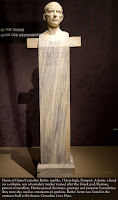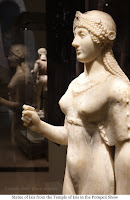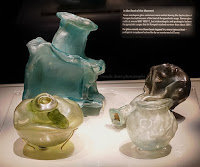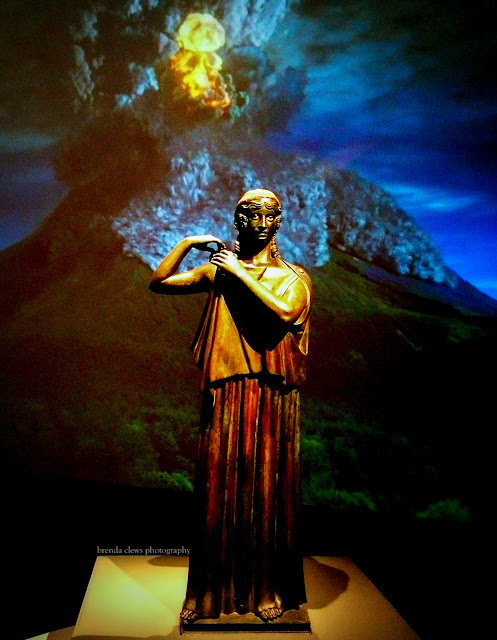On my third trip to POMPEII, in the shadow of the volcano at the Royal Ontario Museum, I found the sex room. Pompeii's protective goddess was Venus Physica Pompeiana, who was a goddess of the sea, and trade. But, surely, the Venus lounging invitingly on the half-shell, a mural perhaps from a brothel, is Venus Pandemos, of the cult of the love goddess “associated with bodily desire (porneia)… her devotes practicing her arts, ta aphrodisiac (caresses and sex)”.
Pompeii died very quickly. On the morning of the explosion of Mount Vesuvius those who lived nearby probably noticed nothing. Midday a cloud “of unusual size and appearance” appeared. Pliny the Younger wrote it was like “a pine tree. It rose into the sky on a very long ‘trunk’ from which spread some ‘branches.’” The thermal energy unleashed by Vesuvius is estimated to be 100,000 times greater than the atomic bomb that incinerated Hiroshima. As the deadly cloud reached Pompeii in AD 79, darkness descended. Light pumice and hot ash fell; escape was possible. The ash cloud collapsed in a series of pyroclastic surges - which are hot, burning clouds that are created in subterranean chambers in heat of up to 900°C and that explode carrying ash, gas and heated rock outwards at speeds of 100km/hr. By early evening, the deaths began. A third of the population died during this phase. Pumice accumulated and crushed buildings. Escape was dangerous, but still possible. By the next morning, everybody else died. Hot gas and fine ash engulfed everything. Pompeii was buried under more than 5 metres of volcanic debris. Of the city of 20,000, archeologists estimate about 2,000 citizens of Pompeii died. Vesuvius is still considered the most dangerous volcano in the world - currently a million people live within the 5-mile radius ’death zone’ of the volcano, and it is due for an eruption.
Pliny the Younger, who escaped Pompeii along with his mother, describes the eruption in AD 79:
…“carts” were “moving in opposite directions, though the ground was…flat….it seemed as though the sea was being sucked backwards….behind us…dark clouds, rent by lightning twisted and hurled, opening to reveal huge figures of flame…. Now came the dust, though still thinly…a dense cloud looms…following us like a flood poured across the land….a darkness came that was not like a moonless or cloudy night, but…like the black of a closed and unlighted room. You could hear women lamenting, children crying, men shouting…. It grew lighter…not a return of day…the fire was approaching…. darkness and ashes came again, a great weight of them. We stood…and shook the ash off again and again, otherwise we would have been covered…and crushed by the weight….I believed I was perishing with the world….At last the cloud thinned… dwindled to no more than fog or smoke….soon…daylight….The sun was even shining, though with the lurid glow it has after an eclipse. The sight that met our still terrified eyes was a changed world, buried in ash like snow.”Pompeii died a city in motion. The site offers an unparalleled glimpse into the day-to-day life of a small Roman city. It was discovered in 1748, and about a third of Pompeii still remains to be excavated. The show at the ROM recreates a semblance of life in Pompeii, and takes us through Pompeiian public and private life with diagrams and photographs of their buildings and homes, the games they played, their entertainment, plays, the gladiator fights they enjoyed, and their religious beliefs, as well as their commerce and trade. Daily artifacts like jewelry, mirrors and clay pots, coins, armoury, and sculptures of the wealthy and of Pompeii’s gods and goddesses are among the 200 objects the ROM has on show from Pompeii. The spurning volcano looms, though, and there are samples of volcanic rock, videos playing on large walls of a volcano blowing and the ash cloud rushing down the sides, enveloping everything in its path. By the end of the show we stand before plaster casts constructed from cavities left by people and animals who perished in the pyroclastic surges that swept through Pompeii. Those who died engulfed by lava are starkly laid out without any fanfare, nothing to prettify them. One is shaken by the immediacy of deaths almost two millennia ago.
In our post-atomic bomb era, we might expect a show on Pompeii to be a meditation on the nearly instant death of a city. While the ROM includes some casts created from the burnt-out remains of those who died during the volcanic eruption, and they are a sobering standstill at the end of a vibrant show, the museum has chosen, for the most part, to focus on Pompeii as a city which died mid-stride, and as an exemplary example of a Roman city in its prime.
What follows is a photo essay of the show - my photographs and descriptions either from the plaques in the show or the booklet the ROM sells of some of the show’s offerings. The show ends January 3, 2016. Do go.



























___________
Quotes from Pliny the Younger’s letter: https://www.utexas.edu/courses/classicalarch/readings/Pliny6-20.html
Also used the $5.00 guide booklet, Pompeii, in the Shadow of the Volcano, Paul Denis and Kate Cooper, published by the ROM to help with describing the photographs.
This article has been published at newz4u.net
___


 Pompeii: In the Shadow of the Volcano
Pompeii: In the Shadow of the Volcano



No comments:
Post a Comment